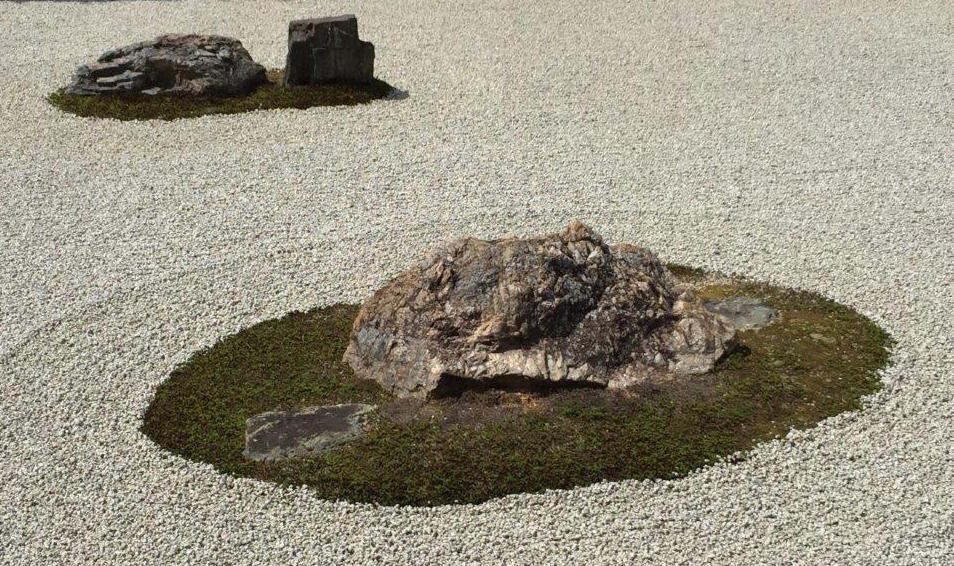Guest Blog Article by Gudrun Traumann
Gudrun Traumann is an independent trainer for sales and creativity techniques for sales, marketing and PR and works as a coach and consultant. She advises entrepreneurs, executives and sales people.
Gudrun’s clients benefit from her many years of professional experience and her broad experience in marketing, PR, sales and human resources management. A clear and structured working method, empathy and practical training are characteristics of her working style.

What does a good presentation have in common with a Japanese stone garden?
My client opens his laptop and gives me his presentation for the next team meeting - from a sales perspective - in his own words.
Clear structure, plenty of headlines, even more bullet points, graphics, numbers, data, facts. He is satisfied - me, not so much.
How can I persuade him to revise his presentation without telling him to. I tell him a story from my last holiday.
When I visited Kyoto, I wanted to see the Ryoan-ji stone garden. High humidity, 28° in the shade and a long subway ride were not going to deter me.
The garden was laid out in the middle of a temple and, as usual in Japan, all shoes were left at the entrance so I entered the building in my socks. I found the stone garden in an inner courtyard, presented like a stage in a theatre. I sat down on the steps which invited me to linger.

Perspective: Where do I have the best overview of the garden? As I pondered, a group of visitors who came behind me questioned the number of stones. From their perspective, they couldn’t see all the stones. The smaller ones were hidden behind the big ones. A change of position gives a different perspective. Before your presentation, play with the perspective: my point of view, the view of a third person or the view of the listener.
Reduction: In the garden there are only stones - large and small. What is the content of your presentation? Reduce it to the bare essentials. If everything is important, what is really important?
Grouping: The fifteen stones are arranged in five groups. If you have a lot to say, sum up your points by topic. Set a clear arrangement with focus points.
Quiet: Only the stones, without distractions (the visiting group had disappeared); a clear grouping radiates a pleasant calm. Simple pictures and graphics with a clear message can transform the design of your presentation.
Simplicity: How pleasant the simplicity of the garden was. Our daily life is complex, remove the complexity from your presentation, have sufficient courage for self-restraint and naturalness. Your core message will be remembered.
Guide the thoughts: The garden is surrounded on three sides by stone walls. The view can not wander into the distance. It follows the arrangement of the stones from one group to the other and always tries to capture all of the stones. Using clear steps, guide your audience to your goal.
Empty spaces: Why is the garden still occupying my mind today? Why do I still remember the great stones and their arrangement? It is the spaces - the gravel between the stones - that makes the stones work. Give your ideas these spaces. Let striking ideas and images work on a white surface.
Concentration: There were no green plants in the garden. Only stones, so no distractions. I look at one of the graphics with lots of pictures, bright colors in three-dimensional representation. The listener loses concentration on what the graphic is meant to illustrate.
Contrast: What stands out to the human eye? Differences! In the garden there were large and small stones that give the garden its energy. What contrasts, before-and-after representations, are used to achieve your goal?
Analog: Before you start a presentation, turn your laptop off. Work similarly with paper, felt pens and moderation cards. Programs for presentations offer a variety of effects, which unfortunately can also distract from the content.
Tell a story: Leave the beaten track and introduce the unexpected. Instead of stringing slides together, tell a story from your company or a personal experience.
Rules: Japanese stone gardens are created according to Zen rules. Rules let our creativity rise to top form. Define your rules, set how long you want to talk, and how many slides you will present.
Less is more: Take the opportunity during your presentation to work on your listeners with your voice and eye contact. The slides with pictures and headings are your backdrop.
Tension: Tense? Adopt an upright posture and use authentic language to help you.
Target: What should the listener remember? What is important to you?
http://www.gudrun-traumann.com
Gudrun Traumann is a trainer for goal-oriented communication and helps people to present themselves and their products. For all who are on the international stage, she offers bilingual (German / English) presentation seminars in collaboration with Clive Davies, professional Business English Trainer.











